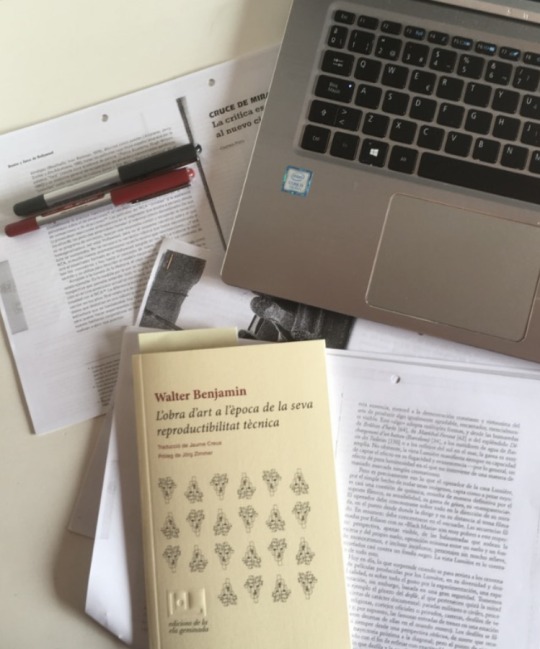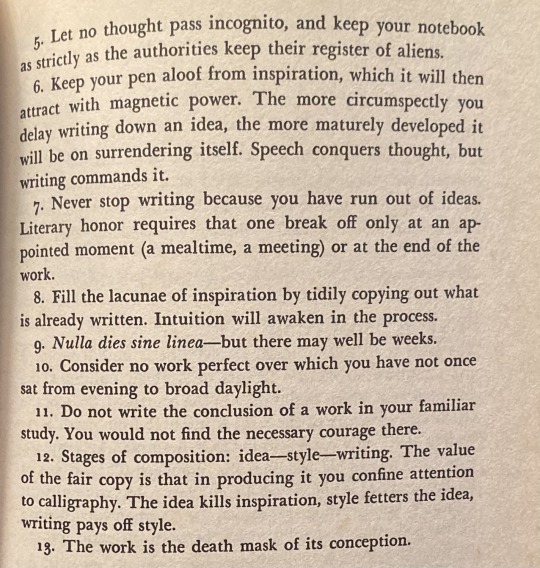#walter benjamin
Text

Banner displayed at the student protests for Palestine at the University of Toronto, posted by assistant professor Esmat Elhalaby on Twitter. The central figure on the bannet is an imitation of Paul Klee's Angelus Novus, famously discussed in Walter Benjamin's Theses on the Philosophy of History. The accompanying text— reading "The only thing in the world worth beginning... the end of the world, of course!"—is from Aimé Césaire's Notebook of a Return to the Native Land.
You can read the Benjamin essay and see the original Klee work here. PDF of the Césaire book here.
1K notes
·
View notes
Text


Currently working on an essay on Walter Benjamin's "The Work of Art in the Age of Mechanical Reproduction".
#study#studyblr#study blog#studygram#student#college#university#essay#studyblr community#studyspo#Walter Benjamin#book#bookblr#bookstagram#reader#writer#writers community#writers on tumblr#neutral palette
707 notes
·
View notes
Text

"Fascism attempts to organize the newly proletarianized masses without affecting the property structure which the masses strive to eliminate. Fascism sees its salvation in giving these masses not their right, but instead a chance to express themselves. The masses have a right to change property relations; Fascism seeks to give them an expression while preserving property. The logical result of Fascism is the introduction of aesthetics into political life. Mankind, which in Homer’s time was a spectacle for the Olympian gods, has become one for itself. Communism responds by politicizing art."
— Walter Benjamin
#late stage capitalism#leftblr#working class#left wing#class war#leftist#news#socialism#communism#walter benjamin
204 notes
·
View notes
Text
#pretty good overview of some of benjamins ideas from the nypl lol#mine#frankfurt school#benjamin#walter benjamin
158 notes
·
View notes
Text

Passage du Saumon, Paris [photo by J. Barry, 1899]
169 notes
·
View notes
Text

Not to find one's way in a city may well be uninteresting and banal. It requires ignorance - nothing more. But to lose oneself in a city - as one loses oneself in a forest - that calls for a quite different schooling. Then, signboard and street names, passers-by, roofs, kiosks, or bars must speak to the wanderer like a cracking twig under his feet in the forest.
-- Walter Benjamin
(Lyon, France)
#cities#lost#signs#walter benjamin#travel photography#lyon#france#street photography#streets#getting lost#urban jungle#quote
152 notes
·
View notes
Text

Walter Benjamin and his son
125 notes
·
View notes
Text


Walter Benjamin, from One-Way Street
993 notes
·
View notes
Quote
Of all the ways of acquiring books, writing them oneself is regarded as the most praiseworthy method.
Walter Benjamin, "Unpacking My Library: A Talk About Book Collecting"
#philosophy#quotes#Walter Benjamin#Unpacking My Library: A Talk About Book Collecting#books#literature#writing#writers
297 notes
·
View notes
Text

{2023} angelus novus (after w.b.)
https://www.marxists.org/reference/archive/benjamin/1940/history.htm
for Scherenschnitt 3.0, a collection of gifs reinterpreting the traditional art of papercuts
#gif#animation#anna malina#black and white#artists on tumblr#original art#paper collage#collage animation#papercuts#laser prints#words#angels#2023#scherenschnitt 3.0#walter benjamin#angelus novus#paul klee
563 notes
·
View notes
Text
Collezioniamo libri pensando di prendercene cura, ma sono loro a prendersi cura di noi.
Walter Benjamin
297 notes
·
View notes
Text

Jean Baudrillard, The Transparency of Evil
321 notes
·
View notes
Text

James Welling — Morgan Great Hall. The Arcades: Contemporary Art and Walter Benjamin (UV-curable ink on Dibond aluminium, 2014)
214 notes
·
View notes
Text
...This may make me a phillistine, but I do find it very funny at how goofy the painting that inspired Walter Benjamin's concept of "The Angel of History" looks.
Like, here is his dramatic description of the painting:
A Klee painting named Angelus Novus shows an angel looking as though he is about to move away from something he is fixedly contemplating. His eyes are staring, his mouth is open, his wings are spread. This is how one pictures the angel of history. His face is turned toward the past. Where we perceive a chain of events, he sees one single catastrophe which keeps piling wreckage upon wreckage and hurls it in front of his feet. The angel would like to stay, awaken the dead, and make whole what has been smashed. But a storm is blowing from Paradise; it has got caught in his wings with such violence that the angel can no longer close them. The storm irresistibly propels him into the future to which his back is turned, while the pile of debris before him grows skyward. This storm is what we call progress.
And now, here is the actual painting:

204 notes
·
View notes
Text
It is significant that the existence of the work of art with reference to its aura is never entirely separated from its ritual function. In other words, the unique value of the “authentic” work of art has its basis in ritual, the location of its original use value. This ritualistic basis, however remote, is still recognizable as secularized ritual even in the most profane forms of the cult of beauty. The secular cult of beauty, developed during the Renaissance and prevailing for three centuries, clearly showed that ritualistic basis in its decline and the first deep crisis which befell it. With the advent of the first truly revolutionary means of reproduction, photography, simultaneously with the rise of socialism, art sensed the approaching crisis which has become evident a century later. At the time, art reacted with the doctrine of l’art pour l’art, that is, with a theology of art. This gave rise to what might be called a negative theology in the form of the idea of ‘pure’ art, which not only denied any social function of art but also any categorizing by subject matter.
“Fiat ars—pereat mundus,” (let art be created, though the world perishes) says Fascism, and, as Marinetti admits, expects war to supply the artistic gratification of a sense perception that has been changed by technology. This is evidently the consummation of “l’art pour l’art.” Mankind, which in Homer’s time was an object of contemplation for the Olympian gods, now is one for itself. Its self-alienation has reached such a degree that it can experience its own destruction as an aesthetic pleasure of the first order. This is the situation of politics which Fascism is rendering aesthetic. Communism responds by politicizing art.
Walter Benjamin, The Work of Art in the Age of Mechanical Reproduction
715 notes
·
View notes
Text
Thematic Analysis of the Storm
In our world, the storm is often associated with white patriarchy and their concept of rational progress. Storm gods like Zeus are often the patriarch of their respective culture, with lightning symbolizing their power of judicial justice: to judge and punish crime before it happens through a set of rigid laws. The storm represents the original trauma of agrarian patriarchs, who had put down roots in farmlands and can lose everything to a single night of bad weather. The patriarchal storm gods represent both the patriarch's fear of the chaotic energy of the storm, but also their desire for its violent power.
With the wide-spread adoption of electricity as "bottled lightning", white patriarchal capitalism believes they have tamed the storm and became gods themselves. We see the same mythologies reinscribed by secular figures like Benjamin Franklin and his lightning-taming kite, Nikola Tesla and his Tesla Coils, and Elon Musk and his electric cars. But have they, really? Capitalist progress had often be likened to a storm itself; consider the following quote from Jewish cultural critic and media theorist Walter Benjamin:
"A Klee painting named ‘Angelus Novus’ shows an angel looking as though he is about to move away from something he is fixedly contemplating. His eyes are staring, his mouth is open, his wings are spread. This is how one pictures the angel of history. His face is turned toward the past. Where we perceive a chain of events, he sees one single catastrophe which keeps piling wreckage upon wreckage and hurls it in front of his feet. The angel would like to stay, awaken the dead, and make whole what has been smashed. But a storm is blowing in from Paradise; it has got caught in his wings with such violence that the angel can no longer close them. This storm irresistibly propels him into the future to which his back is turned, while the pile of debris before him grows skyward. This storm is what we call progress."
The Storm is described as something that reverses progress, even though we know (as of Prisoners of the Cave) that at least one storm had moved time *forward* from the 1910s to the 1960s. Because like the Storm, progress is not actually linear: we've seen there are times and places where humans and arcanists get along better, such as in Charlie's anecdote where class is a much stronger point of conflict; we've also seen there are times and places where the difference between humans and arcanists are not notable distinctions, such as in Pei City where people believe they're not all that different.
In the end, whether the Storm moves time forward, backward, or sideways, it's really just change: somethings come to an end while some other things are reborn. And as with all changes, some like the Foundation would want to control its damage and scope, while others like Manus would capitalize on the chaos and ruin it brings. Both of them believe they can tame the Storm - but will they? Can humans really call themselves the dominant species when they only survive by the grace of an awakened piston? Can arcanists find their promised land in a time when arcanist as a concept may not exist?
27 notes
·
View notes